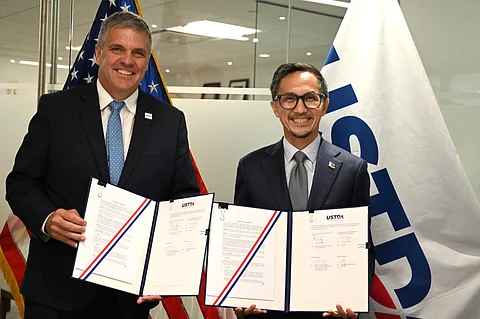
- NEWS
- the EDIT
- COMMENTARY
- BUSINESS
- LIFE
- SHOW
- ACTION
- GLOBAL GOALS
- SNAPS
- DYARYO TIRADA
- MORE

The Philippines and the United States have signed an agreement to advance the development of the Subic-Clark-Manila-Batangas (SCMB) freight railway, a landmark project designed to decongest major ports, lower logistics costs and strengthen regional trade.
The deal was formalized on 25 June in Arlington, Virginia, when Transportation Secretary Vince Dizon and US Trade and Development Agency (USTDA) Acting Director Thomas Hardy signed a memorandum of understanding. Under the accord, the USTDA will provide an estimated $4 million in technical assistance, which includes the development of a transport demand model to forecast cargo flows and optimize routing; a port-rail integration study to assess terminal layouts at Subic, Manila and Batangas; and a comprehensive review of the legal and institutional framework to align policies, tariff structures and customs procedures. A preliminary environmental and social impact assessment will also be undertaken in compliance with Philippine and US standards.
Malacañang confirmed the agreement Friday. Presidential Communications Undersecretary Claire Castro emphasized that the 250-kilometer freight railway will link three of Luzon’s busiest seaports and is expected to transport up to 10 million metric tons of cargo annually once fully operational in 2029.
“The SCMB Railway will be a game-changer for our logistics sector — decentralizing port activity, reducing truck traffic by an estimated 30 percent, and spurring growth in Central Luzon and CALABARZON,” Castro said.
The project will begin with feasibility studies and detailed design work between 2025 and 2026, fully funded by the USTDA. This will be followed by right-of-way acquisition and permitting from 2026 to 2027, spearheaded by the Philippine government. Construction of the Subic–Clark segment is targeted for 2027–2028, followed by the Clark–Manila–Batangas leg in 2028–2029. Test runs and commissioning are expected by late 2029, with commercial operations slated to begin in early 2030.
USTDA’s Hardy noted that the project underscores the strength of the US-Philippine strategic partnership and their shared vision of a free and open Indo-Pacific. “By supporting the SCMB Railway, we are helping build resilient infrastructure that benefits both American exporters and Filipino industries,” Hardy said.
Transportation Secretary Dizon highlighted the railway’s impact, saying it is expected to cut freight transit times by up to 50 percent and reduce delivery costs by an average of 20 percent. He also revealed that the government is eyeing a public-private partnership (PPP) model to fund the estimated $3-billion construction cost, with an initial bidding round expected by late 2026. “We are targeting a balanced PPP structure to leverage private sector expertise while ensuring affordable user fees for our agribusiness and manufacturing sectors,” Dizon said.
Special Assistant to the President for Investment and Economic Affairs Frederick Go described the SCMB Railway as a cornerstone of the Luzon Economic Corridor initiative, which also includes the development of industrial estates and special economic zones near the connected ports. He added that the railway will help generate up to 100,000 jobs during construction and 20,000 permanent positions in operations, warehousing and logistics.
“It will bolster supply-chain resilience and attract international manufacturers to set up in the Philippines,” Go said.
The SCMB freight railway is a flagship infrastructure initiative that not only promises to enhance mobility and competitiveness in Luzon but also reflects the deepening cooperation between the Philippines and the United States in building a stronger, more connected Indo-Pacific region.
